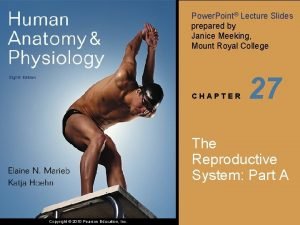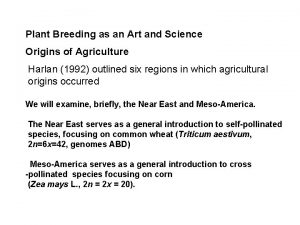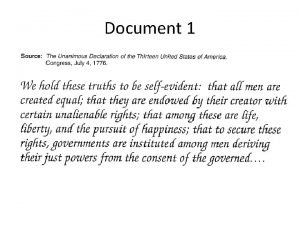Art as Document Art as Document Part of















- Slides: 15

Art as Document

Art as Document • Part of the Realist movement: artist sought to depict the realities of modern life • Empiricism: Evidence! Proof! The scientific method. • Positivism: an objective look at the world. • Details! • John James Audubon: Scientific naturalist/Ornithologist. - He sought to record drawings of the birds of America as well as information about their habitats - His concern for accuracy and effective artistic design make his drawings art. Catlin: presents Native American chiefs as proud and dignified (not bloodthirsty savages as many artists of his time did)

Art as Document (cont) • Eadward Muybridge: Leland Stanford (yes, that Stanford) wanted to prove that all four hooves were off the ground at some point of a horse’s gallop. • Photographs capture details that might escape human eye: the ultimate tool for objective record keeping. • Science as well as art. • “persistence of vision”: try looking at the pictures one after another quickly. It looks like its actually moving, no? That’s because an image lingers for a fraction of a second after seeing it.

Eadward Muybridge Horse Galloping 1878 Collotype print

George Catlin Buffalo Bull’s Back Fat, Head Chief, Blood Tribe 1832 Oil on Canvas 29”x 24”

John James Audubon Watercolor Ivory-Billed Woodpeckers 1829 26” x 39”

Timothy O’Sullivan (1840 -82) • A prominent photographer of the American Civil War and the Western American landscape. • Similar to the landscape artists of the time, O’Sullivan documented the factual naturalism of America. • O’Sullivan infused into his photographs a Romantic sense of awe before the grandeur of nature. • Many of his landscape photographs were meant to suggest human futility and humanity’s insignificant place within the immensity of geological time (Romantic pessimism). • O’Sullivan’s Civil War photographs functioned to impress the public of the war’s high price.

Timothy H. O’Sullivan Ancient Ruins in the Canon de Chelley, Arizona 1873 Albumen print

Timothy H. O’Sullivan The Harvest of Death 1863 Albumen silver print

Alexander Gardner (1821 -82) • One of the Civil War photographers who helped amass over 7, 000 negatives documenting every aspect of the war except the actual fighting, because the cameras were too slow to capture the actual fighting scenes. • Most memorable images were those immediately after a battle, before the dead were buried. • Gardner made a powerful impression on the American public. By depicting the terrible reality of war, he cut through the socalled glamour of it. • Documentary photography significantly impacted how the public perceived reality, especially the reality of war.

Alexander Gardner Confederate dead gathered for burial, Antietam, September 1862 Albumen silver print

Alexander Gardner Abraham Lincoln 1865 Photograph

Jacob Riis (1849 -1914) • Riis was an urban photographer and muckraking journalist who sought to galvanize public concern for the unfortunate poor and bring about social change. • Unlike his contemporaries, Riis actually investigated slum life rather than merely rewriting police reports. • He documented the harsh and difficult living conditions of the urban slums of New York City. • Riis often depicted the inhabitants of the tenements as decent and hardworking people who deserve a better life.

Jacob Riis Five Cents Lodging, Bayard Street 1889

Jacob Riis Tenement Interior in Poverty Gap: An English Coal-Heaver’s Home 1889
 Document.cookie
Document.cookie Tools panel in flash
Tools panel in flash Part part whole addition
Part part whole addition Part to part ratio definition
Part to part ratio definition Part part whole
Part part whole Technical description examples
Technical description examples Different parts of a bar
Different parts of a bar The phase of the moon you see depends on ______.
The phase of the moon you see depends on ______. 미니탭 gage r&r 해석
미니탭 gage r&r 해석 Art-labeling activity: the male reproductive system, part 1
Art-labeling activity: the male reproductive system, part 1 Plant breeding is an art and science
Plant breeding is an art and science Why art has been an integral part in european history
Why art has been an integral part in european history Art interpretation examples
Art interpretation examples Introduction of art appreciation
Introduction of art appreciation High art vs low art examples
High art vs low art examples What is high art and low art
What is high art and low art





























